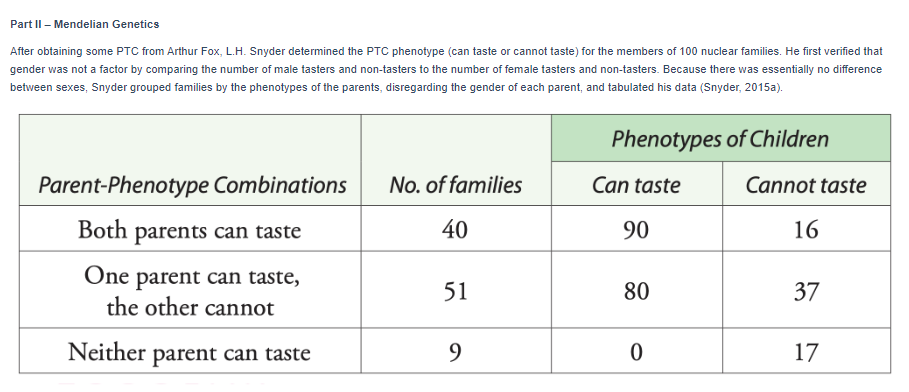What is the significance of the fact that couples who cannot taste PTC never have children who can? Based on these data, what can you conclude about PTC
What is the significance of the fact that couples who cannot taste PTC never have children who can? Based on these data, what can you conclude about PTC
Human Heredity: Principles and Issues (MindTap Course List)
11th Edition
ISBN:9781305251052
Author:Michael Cummings
Publisher:Michael Cummings
Chapter3: Transmission Of Genes From Generation To Generation
Section: Chapter Questions
Problem 18QP: More Crosses with Pea Plants: The Principle of Independent Assortment Determine the possible...
Related questions
Question
-
What is the significance of the fact that couples who cannot taste PTC never have children who can?
-
Based on these data, what can you conclude about PTC taste blindness? What is your evidence?
-
The second parent-
phenotype combination would appear to represent a group of test crosses. What ratios are expected from test crosses and what does each ratio represent? These data don’t seem to fit either of these expected ratios. How can you explain this?

Transcribed Image Text:Part II – Mendelian Genetics
After obtaining some PTC from Arthur Fox, L.H. Snyder determined the PTC phenotype (can taste or cannot taste) for the members of 100 nuclear families. He first verified that
gender was not a factor by comparing the number of male tasters and non-tasters to the number of female tasters and non-tasters. Because there was essentially no difference
between sexes, Snyder grouped families by the phenotypes of the parents, disregarding the gender of each parent, and tabulated his data (Snyder, 2015a).
Phenotypes of Children
Parent-Phenotype Combinations
No. of families
Can taste
Cannot taste
Both parents can taste
40
90
16
One parent can taste,
the other cannot
51
80
37
Neither
parent can taste
9
17
Expert Solution
This question has been solved!
Explore an expertly crafted, step-by-step solution for a thorough understanding of key concepts.
This is a popular solution!
Trending now
This is a popular solution!
Step by step
Solved in 3 steps with 1 images

Knowledge Booster
Learn more about
Need a deep-dive on the concept behind this application? Look no further. Learn more about this topic, biology and related others by exploring similar questions and additional content below.Recommended textbooks for you

Human Heredity: Principles and Issues (MindTap Co…
Biology
ISBN:
9781305251052
Author:
Michael Cummings
Publisher:
Cengage Learning

Biology 2e
Biology
ISBN:
9781947172517
Author:
Matthew Douglas, Jung Choi, Mary Ann Clark
Publisher:
OpenStax

Concepts of Biology
Biology
ISBN:
9781938168116
Author:
Samantha Fowler, Rebecca Roush, James Wise
Publisher:
OpenStax College

Human Heredity: Principles and Issues (MindTap Co…
Biology
ISBN:
9781305251052
Author:
Michael Cummings
Publisher:
Cengage Learning

Biology 2e
Biology
ISBN:
9781947172517
Author:
Matthew Douglas, Jung Choi, Mary Ann Clark
Publisher:
OpenStax

Concepts of Biology
Biology
ISBN:
9781938168116
Author:
Samantha Fowler, Rebecca Roush, James Wise
Publisher:
OpenStax College